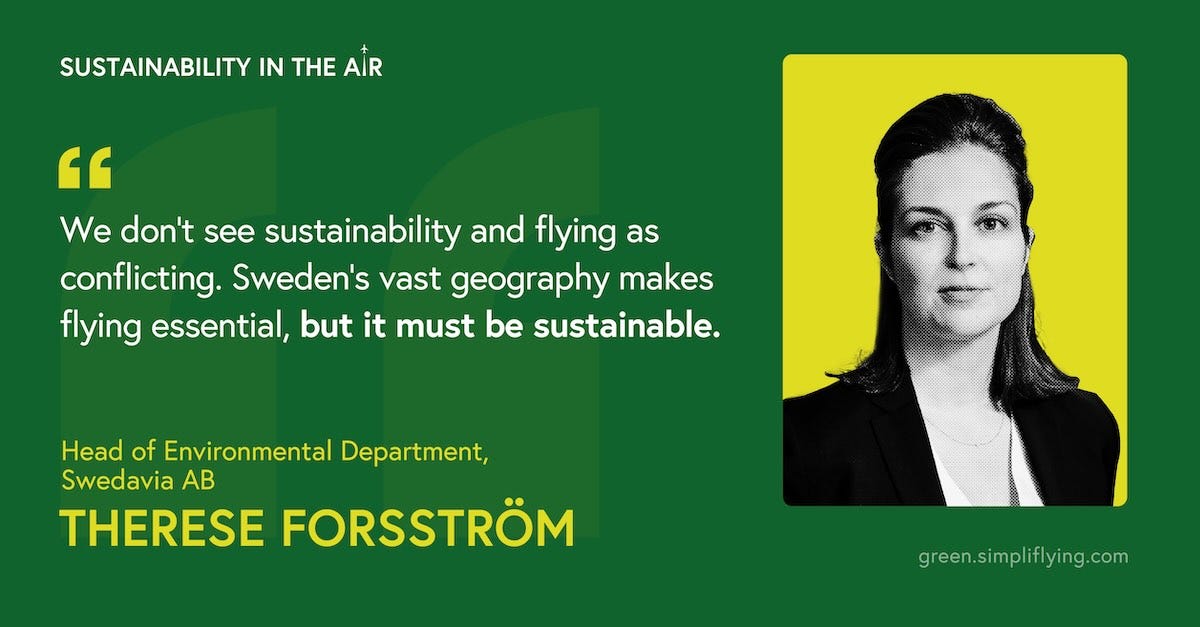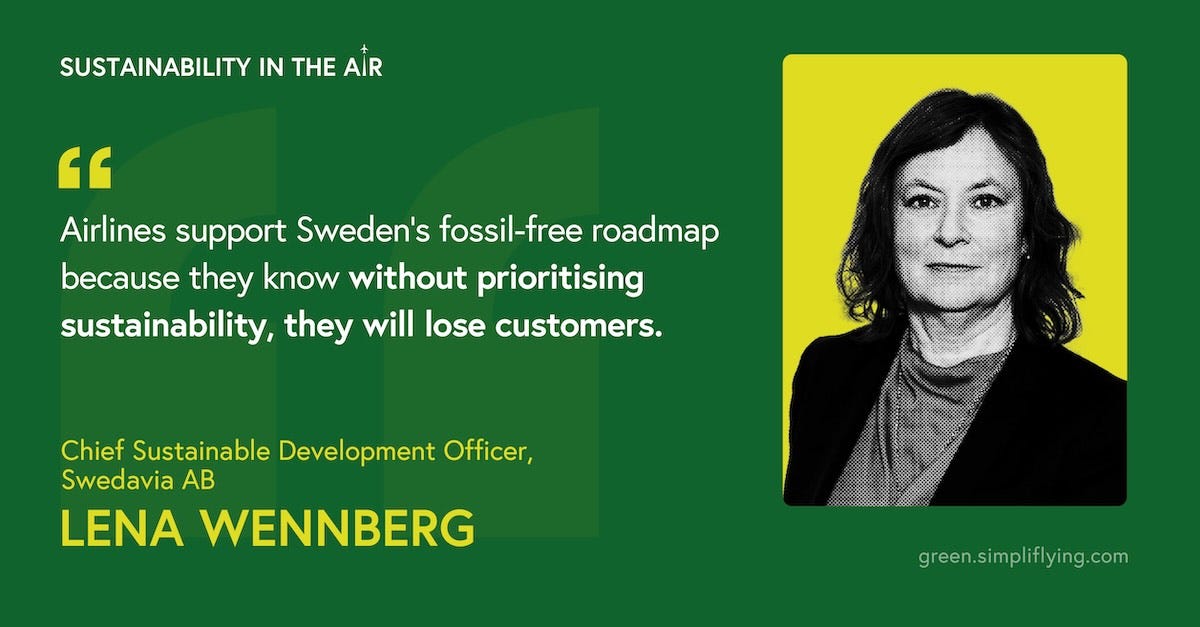In this episode of our ‘Sustainability in the Air’ podcast, Lena Wennberg, Chief Sustainable Development Officer, and Therese Forsström, Head of Environmental Department at Swedavia, speak with SimpliFlying’s CEO Shashank Nigam about their ambitious plans for a fossil-free future.
Swedavia owns and operates 10 airports across Sweden, connecting the country both internally and with the rest of the world. Having achieved fossil-free operations in their own airport activities in 2020, the organisation is now looking to support fossil-free domestic flights in Sweden by 2030.
Here are the key highlights of the conversation:
Swedavia’s fossil-free airport operations since 2020 (3:35)
Airport incentives for airline SAF usage (8:07)
Preparing infrastructure for electric aircraft (10:27)
Collaboration with Airbus on hydrogen (12:18)
Sustainability as a core business priority (15:29)
Balancing growth with environmental commitments (23:07)
Advice for airports starting sustainability journeys (28:25)
Rapid Fire! (30:08)
Keep reading for a detailed overview of the episode.
Why sustainable aviation matters for Sweden
For Swedavia, sustainability isn’t merely an environmental aspiration — it’s a fundamental business necessity.
As Wennberg explains, “From the beginning, a fossil-free airport wasn’t just a goal, it was a vision. Then we got a new CEO who made it a real target for us to strive toward. When our current CEO came in, he showed the same level of commitment.”
“And they all saw this as a license to operate,” chimes in Forsström. “If we don’t do this, we won’t have a license to operate anymore.”
This perspective frames the entire approach Swedavia takes to aviation sustainability. In a country that has experienced significant flight shaming movements, addressing the climate impact of air travel is essential for the industry’s social acceptance and long-term viability.
At the same time, Sweden’s geography creates a genuine need for air transportation. With significant distances between northern and southern regions and a relatively small population distributed across a large area, air travel remains the most practical mode of transport.
The challenge, then, is to maintain the connectivity that air travel provides whilst dramatically reducing its environmental impact. Swedavia’s approach — covering their own operations, airline practices, and ground transportation — illustrates how airports can play an active role in leading aviation’s sustainability transition.
5 takeaways from the conversation
1. The journey to fossil-free airport operations
Swedavia achieved fossil-free operations in their own airport activities in 2020, a milestone that required a decade of focused work. This achievement covers all operations directly under the airport authority’s control, representing a significant step in reducing their scope 1 emissions.
Getting there meant systematically replacing fossil fuels across the board — from airside vehicles to heating systems and backup power — through a series of targeted technical upgrades.
While Swedavia acknowledges that their direct emissions represent just a fraction of the total carbon footprint associated with airports (with aircraft operations and passenger transport to/from airports forming the bulk), they saw it as a crucial first step that demonstrated their own commitment before asking others to change.
Swedavia converted their ground vehicle fleet to electric and biofuel alternatives, implemented renewable heating systems, redesigned backup power infrastructure, and optimised energy consumption across terminal buildings. They also upgraded lighting systems to LED technology throughout their airports, including runways and taxiways, prioritising both energy efficiency and practical implementation.
2. Accelerating Sustainable Aviation Fuel adoption
Central to Swedavia’s plan for fossil-free domestic flights by 2030 is the increased adoption of Sustainable Aviation Fuel (SAF). Additionally, Swedavia has set an environmental goal to ensure that 5% of all jet fuel used at its airports will be renewable by 2025.
“We believe sustainable aviation fuel will be essential,” Wennberg explains. “By 2030, there won’t be enough electric aircraft, and hydrogen aircraft won’t be a viable option. So, we’ll have to depend on sustainable aviation fuel.”
Sweden has set a target to achieve 10% SAF usage in domestic aviation by 2030, well above the 6% required by the European Union’s ReFuelEU Aviation initiative, says Wennberg. In 2024, SAF made up about 2.2% of aviation fuel in Sweden, which was significantly higher than the global average of 0.6%, she adds.
To drive SAF adoption, Swedavia has implemented an innovative incentive programme where they offer discounts and reimburse up to 50% of the premium cost when airlines refuel with SAF. This direct financial support helps address the price differential between conventional jet fuel and more expensive sustainable alternatives. Additionally, Swedavia purchases SAF to offset their own business travel emissions, a practice they’ve maintained for nearly nine years.
3. Preparing infrastructure for future aircraft technologies
While SAF represents the primary near-term solution, Swedavia is actively preparing their infrastructure for the next generation of aircraft technologies, particularly electric and hydrogen propulsion systems.
For electric aircraft, preparations are already underway:
“We have a plan to welcome electric aviation when it arrives,” Wennberg says. “Our smaller airports, like Visby, Östersund, and Umeå, can currently charge smaller electric aircraft. But not the large commercial ones. At Arlanda, we’re preparing stand 11, located close to the terminal. By next year, we’ll be ready to welcome commercial electric aircraft with a mega charging system.”
Swedavia has also participated in tests of ground handling procedures for electric aircraft through the ELISE project, with key partners such as Heart Aerospace, and airlines BRA and SAS As part of this initiative, Swedavia has made Malmö Airport available as a test arena for Heart Aerospace’s ES-30 electric aircraft, to host full-scale model tests and demonstrate taxiing and charging capabilities.
Swedavia’s role goes beyond infrastructure. “We’re part of the Heart Aerospace Advisory Board, just to stay informed about what’s happening,” says Wennberg. That involvement helps ensure airport readiness while giving aircraft developers insights into what’s required on the ground.
And it doesn’t stop with electricity. Last year, Swedavia joined Airbus, Avinor, SAS, and Vattenfall in signing a Memorandum of Understanding (MoU) to explore hydrogen infrastructure at airports in Sweden and Norway. “We’ve been conducting the study for a year now [..] We’re looking into what needs to be done — whether we need to produce the hydrogen ourselves at the larger airports, or if we can rely on regional supply, for example,” Wennberg shares.
4. Aligning sustainability with core business strategy
Swedavia has seamlessly integrated sustainability into its business model, where environmental goals are treated as central objectives, on par with financial performance, rather than as secondary or corporate social responsibility initiatives, says Wennberg.
“Airport sustainability is a top priority goal at Swedavia, and a key part of our business plan. It’s on the same level as our economic and passenger goals. It carries the same weight as those objectives, which is why we’ve been working on it for such a long time — since 2010,” Forsström emphasises.
Swedavia has also attained the highest level of the ACI World’s Airport Carbon Accreditation (ACA) programme for four of their ten airports. ACA is a globally recognised carbon management certification program for airports. It independently evaluates and acknowledges airports' efforts to manage and reduce carbon emissions across 7 certification levels.
Swedavia plans to ensure that all its 10 airports reach the highest ACA certification level by 2026. The organisation has also been actively involved in developing these standards through participation in ACA task forces and working groups.
5. Building an ecosystem for aviation sustainability
The final piece of Swedavia’s sustainability strategy involves fostering an ecosystem of partners and stakeholders all working toward the same goals. This collaborative approach recognises that no single entity — airport, airline, or manufacturer — can address the climate impact of aviation alone.
Government policy plays a vital role in this ecosystem:
“We base Swedavia’s climate work on the Swedish government’s Fossil Free Sweden initiative, which aims for Swedish domestic air travel to be fossil-free by 2030. This goal is aligned with Sweden’s broader climate objectives.” Forsström explains. This initiative brings together industry stakeholders to develop roadmaps for decarbonisation across various sectors.
For airports just beginning their sustainability journey, Wennberg offers practical advice: “Begin by assessing your carbon footprint and focusing on the low-hanging fruit. It’s not just about costs – you can actually save money by being more efficient, reducing energy use, switching to cheaper electricity, and working towards being fossil-free in the future. It’s a simple first step: calculate your carbon footprint, identify areas to reduce. Being more efficient can help you save money and reduce emissions.”
As the climate crisis continues, Swedavia’s multifaceted approach, focusing on operational improvements, fuel innovation, infrastructure development, business integration, and ecosystem building, provides a model for airports worldwide to actively contribute to the sustainable transformation of aviation.
‘Sustainability in the Air’ is the world’s leading podcast dedicated to sustainable aviation. Through in-depth conversations with top aviation leaders, we break through the clutter and provide a clear roadmap for a net-zero future.















